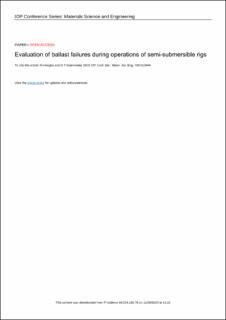| dc.contributor.author | Unegbu, Ihuaku Nneoma Kelechi | |
| dc.contributor.author | Gudmestad, Ove Tobias | |
| dc.date.accessioned | 2023-02-03T10:30:06Z | |
| dc.date.available | 2023-02-03T10:30:06Z | |
| dc.date.created | 2019-12-05T12:40:17Z | |
| dc.date.issued | 2019 | |
| dc.identifier.citation | Unegbu, N., & Gudmestad, O. T. (2019, November). Evaluation of ballast failures during operations of semi-submersible rigs. In IOP Conference Series: Materials Science and Engineering (Vol. 700, No. 1, p. 012044). IOP Publishing. | en_US |
| dc.identifier.issn | 1757-8981 | |
| dc.identifier.uri | https://hdl.handle.net/11250/3048240 | |
| dc.description.abstract | Risk analysis/assessment is one of the challenges encountered during operations of offshore units on the Norwegian Continental Shelf (NCS). In recent years, the Petroleum Safety Authority (PSA) has focused on hazards relating to floating installations and thus requested that more attention should be made by the industry on hazards relating to buoyancy loss and stability. Ballast systems play a very vital role to ensure vessel stability. Various failure modes of semi-submersible ballast systems are identified and possible barriers and consequences due to the ballast system failure during drilling operation are considered. The failure mode effect and criticality analysis (FMECA) of the main components of the semi-submersible's ballast system is adopted to determine the failure causes and failure modes that could influence each components performance, and thus identifying the most critical component(s). The Structured What-If Technique (SWIFT) is used to compensate for hazard identification for the unidentified hazards (i.e., human errors), in the FMECA. By studying the most critical system components, a qualitative risk analysis is conducted to model accidental sequences by using the fault tree method to establish the chain of failure events. The result of the Structured What If Analysis (SWIFT) shows that maloperation of the ballast system is the main contributing failure cause. This involves, failure to properly describe ballast procedure, failure to follow ballast plan, wrong sequence of closing/opening valve, maloperation of valve, time pressure complacency, communication gap or general lack of knowledge of the system. The FMECA findings indicate that failure of valves to "close on demand" with a Risk Priority Number (RPN) of 60, is the most critical. | en_US |
| dc.language.iso | eng | en_US |
| dc.publisher | IOP Publishing | en_US |
| dc.rights | Navngivelse 4.0 Internasjonal | * |
| dc.rights.uri | http://creativecommons.org/licenses/by/4.0/deed.no | * |
| dc.title | Evaluation of ballast failures during operations of semi-submersible rigs | en_US |
| dc.type | Peer reviewed | en_US |
| dc.type | Journal article | en_US |
| dc.description.version | publishedVersion | en_US |
| dc.rights.holder | The authors | en_US |
| dc.subject.nsi | VDP::Teknologi: 500 | en_US |
| dc.source.pagenumber | 1-10 | en_US |
| dc.source.volume | 700 | en_US |
| dc.source.journal | IOP Conference Series: Materials Science and Engineering | en_US |
| dc.source.issue | 1 | en_US |
| dc.identifier.doi | 10.1088/1757-899X/700/1/012044 | |
| dc.identifier.cristin | 1757115 | |
| cristin.ispublished | true | |
| cristin.fulltext | original | |
| cristin.qualitycode | 1 | |

